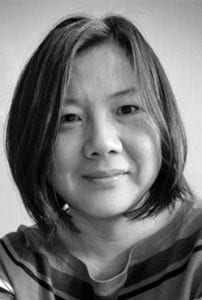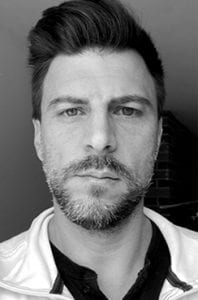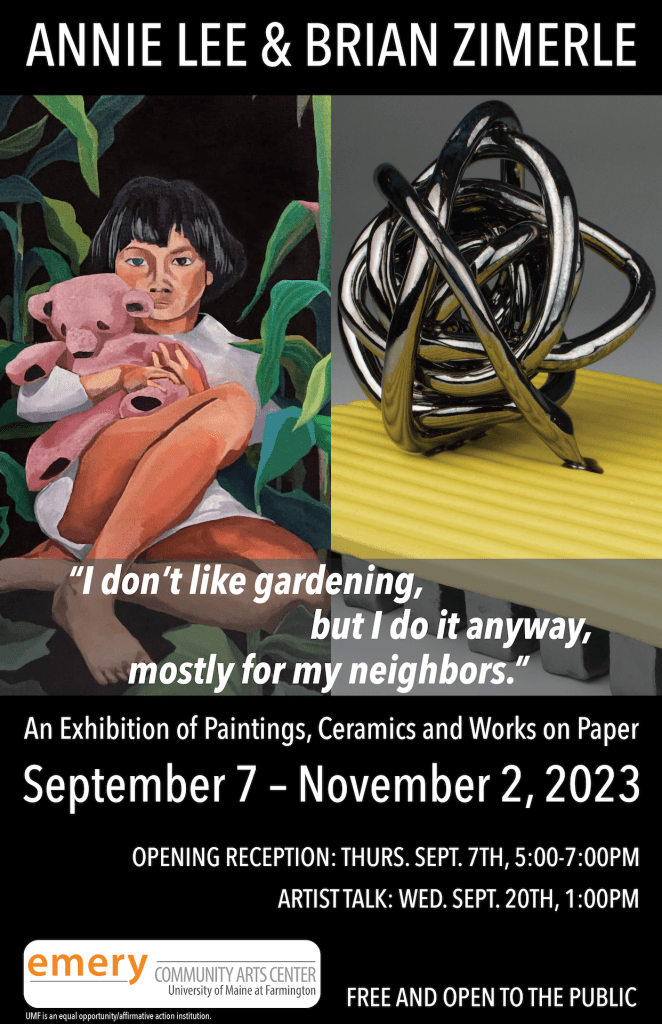Annie Lee and Brian Zimerle
“I don’t like gardening, but I do it anyway, mostly for my neighbors.”
September 7 – November 2, 2023
Opening Reception: 9/7/23, 5:00-7:00pm
Artist Talk: 9/20/23, 1:00pm //LINK TO ARTIST TALK\\
Free and open to the public
In their new multi-media exhibition, “I don’t like gardening, but I do it anyway, mostly for my neighbors,” Annie Lee and Brian Zimerle consider the act of gardening as engaging an intention of domesticity, from the literal domestication of wild flora to the more common ideal of making a home a home. The exhibition includes paintings, ceramics, book arts and works on paper.
 Annie Lee-Zimerle is a visual artist with a background in printmaking, book arts, painting and drawing. Her work is often narrative based and a reflection of her thoughts on domesticity and the mundaneness of culture. Born in South Korea and raised in the Midwest, Lee-Zimerle received a BFA and MFA from the School of the Art Institute of Chicago. Lee-Zimerle’s work has been exhibited nationally and internationally in museums and galleries and is in numerous private and public collections, including the Dayton Metro Library in Dayton, Ohio, Springfield Museum of Art in Ohio, Harold Washington Public Library in Chicago, Joan Flash Artists’ Book Collection, and Maine Women Writers Collection. Her recent residencies and fellowships include Cleveland Institute of Art and the Studios at MASS MoCA. She was also featured on The Art Show on PBS. Lee-Zimerle is currently an Associate Professor of Art and Faculty Director of the Kate Cheney Chappell Center for Book Arts at University of Southern Maine.
Annie Lee-Zimerle is a visual artist with a background in printmaking, book arts, painting and drawing. Her work is often narrative based and a reflection of her thoughts on domesticity and the mundaneness of culture. Born in South Korea and raised in the Midwest, Lee-Zimerle received a BFA and MFA from the School of the Art Institute of Chicago. Lee-Zimerle’s work has been exhibited nationally and internationally in museums and galleries and is in numerous private and public collections, including the Dayton Metro Library in Dayton, Ohio, Springfield Museum of Art in Ohio, Harold Washington Public Library in Chicago, Joan Flash Artists’ Book Collection, and Maine Women Writers Collection. Her recent residencies and fellowships include Cleveland Institute of Art and the Studios at MASS MoCA. She was also featured on The Art Show on PBS. Lee-Zimerle is currently an Associate Professor of Art and Faculty Director of the Kate Cheney Chappell Center for Book Arts at University of Southern Maine.
 Brian Zimerle (b. Defiance, OH) is a ceramist and sculptor who lives and works in Falmouth, Maine. He has taught at various universities and is currently an adjunct at the University of Southern Maine, teaching sculpture and ceramics. He was previously the lead mountmaker at the Penn Museum whose collection has significant influence on his work. He draws inspiration from the science, history, or memory of objects from the human built environment. His process is centered on replication but fully embraces generation loss; whether that loss is from the transmutation of material or the filter of his memory. His work is often the physical diminished replica, leaving an object that bears little semblance to the original yet retains a charged presence. He has shown regionally and nationally, including the Springfield Museum of Art, the Zanesville Museum of art, the ISAC at the University of Chicago, and many other galleries and institutions.
Brian Zimerle (b. Defiance, OH) is a ceramist and sculptor who lives and works in Falmouth, Maine. He has taught at various universities and is currently an adjunct at the University of Southern Maine, teaching sculpture and ceramics. He was previously the lead mountmaker at the Penn Museum whose collection has significant influence on his work. He draws inspiration from the science, history, or memory of objects from the human built environment. His process is centered on replication but fully embraces generation loss; whether that loss is from the transmutation of material or the filter of his memory. His work is often the physical diminished replica, leaving an object that bears little semblance to the original yet retains a charged presence. He has shown regionally and nationally, including the Springfield Museum of Art, the Zanesville Museum of art, the ISAC at the University of Chicago, and many other galleries and institutions.


Comments are closed.